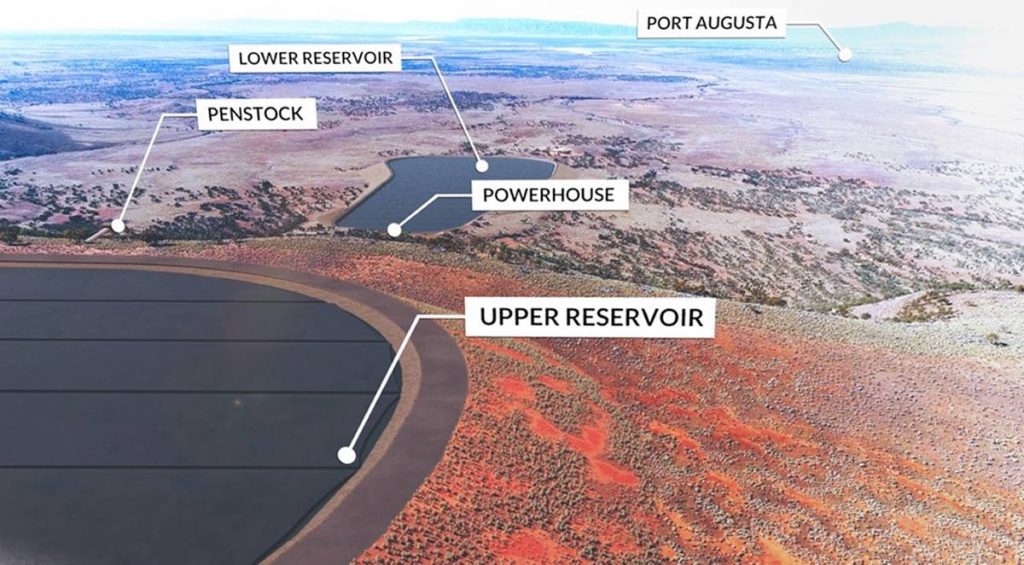
Goat Hill Project | Image: Altura Group
Pumped hydro storage projects made up half of the projects shortlisted under the Morrison Government’s Underwriting New Generation Investments program.
66 proposals were submitted for consideration and from those, 12 projects have been shortlisted – six pumped hydro storage, five gas and one coal power upgrade project.
If you’re not familiar with what pumped hydro storage is, an article we published yesterday provides a brief description and a couple of diagrams of how it works.
Here’s a very quick look at some of the pumped hydro storage projects to make the shortlist.
Goat Hill – South Australia
To be developed by Altura Group and Delta Electricity, Goat Hill Pumped Storage Hydro Project will be a 230MW1 facility located 12 km west of Port Augusta. Learn more here.
Baroota – South Australia
Rise Renewables’ Baroota pumped hydro storage project will be located 40 kilometres north-east of Port Pirie. The facility is being designed for between 200 and 270 MW of capacity and storage for up to 8 continuous hours of generation. Learn more here.
Tasmania
Tasmania’s “Battery Of The Nation” project involves multiple sites. The Australian Renewable Energy Agency (ARENA) had previously identified 14 ‘high potential’ locations and Hydro Tasmania says Lake Cethana (600MW), Lake Rowallan (600MW) and Tribute (600MW) have emerged as the most promising candidates. Hydro Tasmania states it is continuing pre-feasibility work on the remaining sites. Learn more here.
Middleback Range – South Australia
Simec Zen Energy’s Middleback Range Pumped Hydro Project on the Eyre Peninsula will convert a depleted iron ore pit into a 90MW, four hour storage system. Learn more here.
The other two shortlisted projects are a UPC Renewables project in Armidale, New South Wales and a BE Power Solutions facility at Cressbrook Reservoir in Crows Nest, Queensland.
It’s interesting half the shortlisted projects are located in the country’s driest state – South Australia – and there’s other pumped hydro facilities planned for SA. While water in pumped hydro facilities is continuously re-used in the systems, at least one of the projects listed above, Goat Hill (pictured above), will use a cover over its reservoirs to minimise evaporation and top-ups. As we mentioned yesterday, another project in SA will use seawater, with the ocean as its lower reservoir. It makes sense for SA to get into pumped hydro storage in a big way given the amount of large-scale renewables in the state.
Those shortlisted will now need to lodge more detailed proposals before a final decision is made.
Coal Pushed Out, But..
There were concerns the Morrison Government’s Underwriting New Generation Investments program would support a bunch of coal projects2. However, only one got a look-in – an “upgrade” for a coal fired clunker in Lake Macquarie, New South Wales (so either Vales Point or Eraring).
But the Coalition Government’s love affair with coal power isn’t over yet – Prime Minister Morrison has also announced a feasibility study will be carried out in relation to a proposal to build a new coal-fired power station in North Queensland.
Barnaby Joyce appears somewhat placated – for now.
Footnotes
- Altura’s page mentions 230MW and also “capacity of up to 250 MW and 8 hours of storage” ↩
- Questions were also raised as to whether Federal Energy Minister Angus Taylor had constitutional authority over electricity and authority to fund projects under the program ↩

 RSS - Posts
RSS - Posts



I just lost my comments this maybe a repeat
Pumped Hydro is a fair closed loop system as most of the above are. Snowy 2 is very far from is generation source. So we will loose twice to transmission losses to and fro, pump up efficiency is about 40%. Pelton wheel turbines are about 80% .
I see for 100Kw in we get 2-3Kw back and that will not change as it’s all mechanical.
Hydrogen electrolysis is currently30% efficient and Harvard material scientists are proving 70% efficient anodes currently.
Why spend Billions on Pumped Hydro when you can convert at the source to H2 and store in existing mains as a shandy with existing gas. This can be converted back to electricity by Blue Tech Methane Fuel cells at 95%+ or run through existing Gas Turbines. Or stored in tanks which are currently available from Aus suppliers.
The gas system can tolerate up to 20% H2 without domestic jet changes.
Eventually we can fully migrate to H2 town gas. This can be a stepped change using existing and new processes and will get more efficient over time